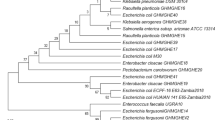Abstract
Acacia spp. produce gum exudates, traditionally called gum arabic or gum acacia, which are widely used in the food industry such as emulsifiers, adhesives, and stabilizers. The traditional gum arabic is highly variable with average molecular weights varying from 300,000–800,000. For this reason a standardized sample was used for the present experiments, based on a specific species of gum arabic (Acacia(sen)SUPER GUMTM EM2). The literature indicates that gum arabic can be fermented by the intestinal bacteria to short chain fatty acid, particularly propionate. However, the bacteria responsible for the fermentation have not been determined. In this study, we used enrichment culture of pig cecal bacteria from the selected high molecular weight specific gum arabic of (MW 1.77 × 106). We found Prevotella ruminicola-like bacterium as a predominant bacterium that is most likely to be responsible for fermentation of the gum arabic used to propionate.


Similar content being viewed by others
Literature Cited
Adiotomre J, Eastwood MA, Edwards CA, Gordon Brydon W (1990) Dietary fiber: in vitro methods that anticipate nutrition and metabolic activity in humans. Am J Clin Nutr 52:128–134
Al-Assaf S, Phillips GO, Williams PA (2005) Studies on acacia exudate gums, Part I: The molecular weight of Acacia senegal gum exudate, Food Hydrocolloid 19:647–660
Annison G, Trimble RP, Topping DL (1994) Feeding Australian Acacia gums and gum arabic leads to non-starch polysaccharide accumulation in the cecum of rats. J Nutr 125:283–292
Arakaki C, Mitsumori M, Itabashi H, Shirasaka S, Minato H (1994) Influence of the presence of protozoa on the rumen microbial population of cattle. J Gen Appl Microbiol 40:215–226
Benno Y, Endo K, Mizutani T, Namba Y, Komori T, Mitsuoka T (1989) Comparison of fecal microflora of elderly persons in rural and urban areas of Japan. Appl Environ Microbiol 55:1100–1105
Bentz DE, Byers FM, Schelling GT, Greene LW, Lunt DK, Smith SB (1989) Ionophores alter hepatic concentrations of intermediary carbohydrate metabolism in steers. J Anim Sci 67:2393–2399
Cummings JH, Pomare EW, Branch WJ, Naylor CP, Macfarlane GT (1987) Short chain fatty acids in human large intestine, portal, hepatic and venous blood. Gut 28:1221–1227
Godon JJ, Zumstein E, Dabert P, Habouzit F, Moletta R (1997) Molecular microbial diversity of an anaerobic digestor as determined by small-subunit rDNA sequence analysis. Appl Environ Microbiol 63:2802–2813
Holdeman LV, Cato EP, Moore WEC (1974) Anaerobic laboratory manual, 4th ed. Blacksburg, VA: Virginia Polytechnic Institute and State University, 152 pp
Inoue R, Ushida K (2003) Development of the intestinal microbiota in rats and its possible interactions with the evolution of the luminal IgA in the intestine. FEMS Microbiol Ecol 45:147–153
Jarrige R (1980) Alimentation des Ruminants. INRA Publications. CNRA Route de Saint-Cyr, Versailles, France: pp 621
May T, Mackie RI, Fahey GG, Cremin JC, Garleb KA (1994) Effect of fiber source on short-chain fatty acid production and the growth and toxin production by Clostridium difficile. Scand J Gastroenterol 19:916–922
Michel C, Kravtchenko TP, David A, Gueneau S, Kozlowski F, Cherbut C (1998) In vitro prebiotic effects of Acacia gums onto the human intestinal microbiota depends on both botanical origin and environmental pH. Anaerobe 4:257–266
Ørskov ER (1982) Protein nutrition in ruminants. London: Academic Press. 160 pp
Osman ME, Williams PA, Menzies AR, Philips GO (1993) Characterisation of commercial samples of gum arabic. J Agric Food Chem 41:71–77
Overton TR, Drackley JK, Ottemann-Abbamonte CJ, Beaulieu AD, Emmert LS, Clark JH (1999) Substrate utilization for hepatic gluconeogenesis is altered by increased glucose demand in ruminants. J Anim Sci 77:1940–1951
Randall RC, Phillips GO, Williams PA (1988) The role of the proteinaceous component on the emulsifying properties of gum arabic. Food Hydrocolloid 2:131–140
Randall RC, Phillips GO, Williams PA (1989) Fractionation and characterisation of gum from Acacia Senegal. Food Hydrocolloid 3:65–75
Remesy C, Demigne C, Morand C (1995) Metabolism of short chain fatty acids in the liver. In: Cummings JH, Rombeau JL, Sakata T (eds) Physiological and clinical aspects of short chain fatty acids. Cambridge: Cambridge University Press. pp 171–190
Sakata T (1997) Influence of short-chain fatty acids on intestinal growth and functions. In: Kritchevsky D, Bonfield C (eds) Dietary fiber in health and disease. New Yolk: Plenum Press. pp 191–199
Stewart CS, Bryant MP (1988) The rumen bacteria. In: Hobson PN (ed) The rumen microbial ecosystem. New York: Elsevier Applied Science, pp 21–76
Tsukahara T, Koyama H, Okada M, Ushida K (2002) Stimulation of butyrate production by gluconic acid in batch culture of pig cecal digesta and identification of butyrate-producing bacteria. J Nutr 132:2229–2234
Vallimont JE, Varga GA, Arieli A, Cassidy TW, Cummins KA (2001) Effects of prepartum somatotropin and monensin on metabolism and production of periparturient Holstein dairy cows. J Dairy Sci 84:2607–2621
Weatherburn MW (1967) Phenol-hypochlorite reaction for determination of ammonia. Anal Chem 39:971–974
Author information
Authors and Affiliations
Corresponding author
Rights and permissions
About this article
Cite this article
Kishimoto, A., Ushida, K., Phillips, G.O. et al. Identification of Intestinal Bacteria Responsible for Fermentation of Gum Arabic in Pig Model. Curr Microbiol 53, 173–177 (2006). https://doi.org/10.1007/s00284-005-0219-3
Received:
Accepted:
Published:
Issue Date:
DOI: https://doi.org/10.1007/s00284-005-0219-3




